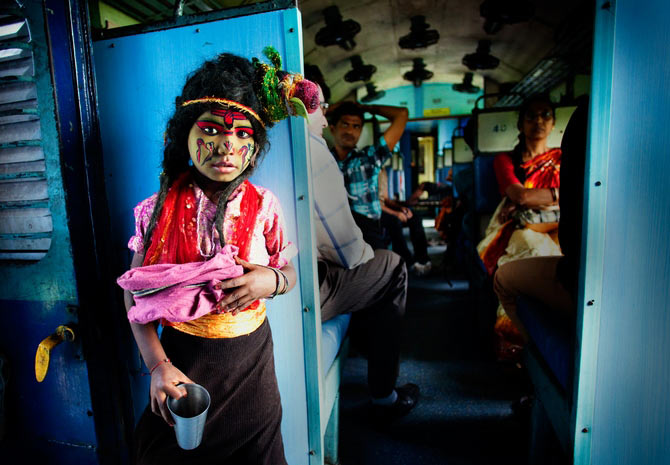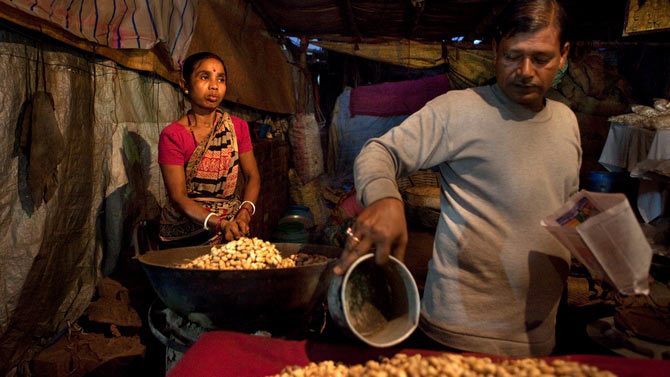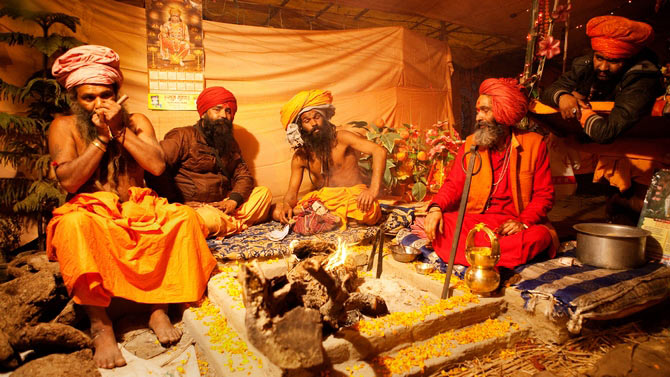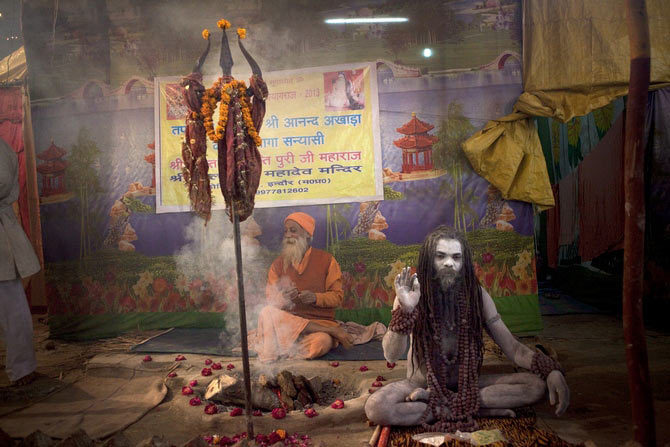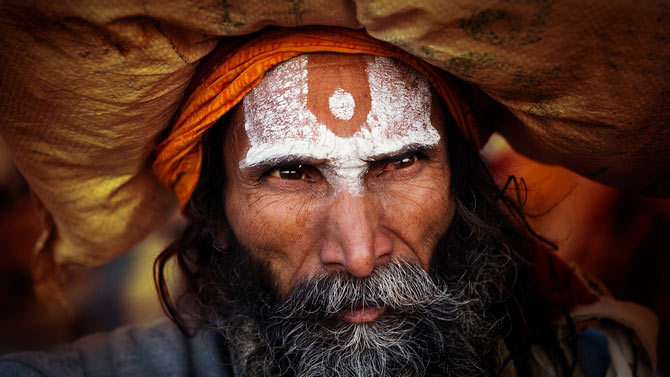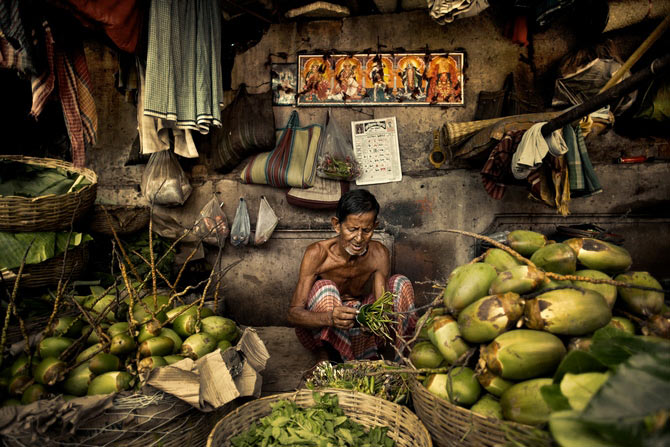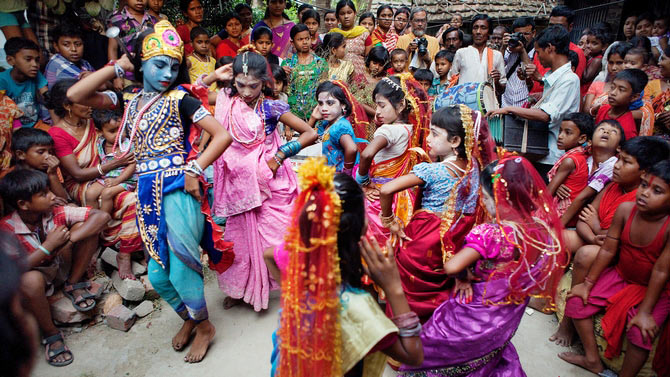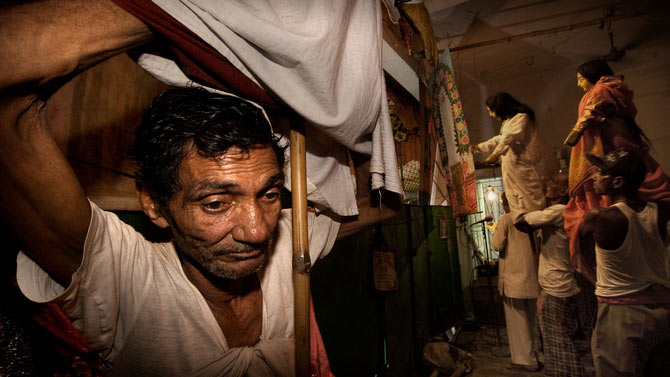 | « Back to article | Print this article |
Amazing photos that capture the story of India
Taking photographs of people on the streets has made Dr Arup Ghosh, a winner at the 2014 Sony World Photography Awards, more thankful of what life has offered him. He tells Rediff.com what it takes to be a good street photographer.
A young boy, no older than seven years, looks straight at you.
He is dressed as Shiva, and the steel water glass he holds doubles up as his begging bowl.
As he stands at the doorway having completed his round of the train compartment, he looks at the camera perhaps in the hope of receiving alms from the photographer.
The picture, shot by Dr Arup Ghosh, a physician in Bhadreswar, a town about 30 km from Kolkata, was adjudged the best in the 'People' category of the 2014 Sony World Photography Awards.
In an interview with Rediff.com, Dr Ghosh talked about his award-winning image, just how he got behind the camera and what it takes to get a good street photograph.
Tell us about the picture (above) that won you an award at the 2014 Sony World Photography Awards.
I was on vacation, travelling by a local train for Durga Puja festivities when I saw this boy singing devotional songs and begging for alms.
He was guised as (the Hindu god) Shiva.
This is a common sight in Indian trains -- young children dressing as gods and asking for alms.
But this boy was charming, bright and did have a melodious voice.
No one from our train compartment gave him any money so he was sad and was singing alone, standing by the door.
Our destination was arriving and we approached the door.
My camera was ready, hanging on my neck, with the 20mm wide lens attached.
I took three shots of the boy and got off the train.
Before leaving, my daughter gave him an apple and I gave him some money.
The boy moved to the next compartment happily.
These children are from very poor family. Their parents are daily wage labourers. They work long days in the fields while their children sing and beg on trains. Yet they are cheerful, happy and friendly.
This was one of the 20 photographs I'd submitted for the contest.
It won in the 'People' category.
Please click NEXT to see more stunning photographs and read the interview...
Amazing photos that capture the story of India
What draws you towards street people photography?
For one, it is simpler to take pictures of people for me because the place where I stay is densely populated.
But apart from that, what draws me towards street people photography is the awareness that everyone has a unique story to tell.
I am attracted by these untold stories and people's emotions and the struggles.
Earlier, I used to sketch a lot.
Now, my job as a medical officer doesn't leave me with enough time to do that.
Photography comes close second.
I've been shooting since 2005. If I don't take photographs for more than seven days, I begin to feel restless.
Why do you take photos?
My job as a physician helps me earn my bread and butter.
But photography treats my soul.
Please click NEXT to see more stunning photographs and read the interview...
Amazing photos that capture the story of India
What challenges have you faced while taking pictures of people on the streets?
Today, because camera equipment is more accessible, many people are purchasing DSLRs.
So, suddenly you have a lot more photographers on the streets than you used to.
Many of these photographers demand a lot from their subjects.
They ask them to pose a certain way, smile a certain way etc.
I have noticed that a lot of people are getting averse to being photographed these days; they get irritated more easily; they are less patient.
When you're doing street photography, you cannot arrange a picture. You have to capture the image as it exists. Many 'street photographers' don't seem to get that.
Please click NEXT to see more stunning photographs and read the interview...
Amazing photos that capture the story of India
How were you introduced to photography?
I was first moved by the work of Raghu Rai.
His pictures of the Bhopal Gas Tragedy affected me a great deal as did his portrait of Mother Teresa.
Eventually I was also introduced to the works of (the Brazilian social documentary photographer) Sebastiao Salgado and (the American photographer) Mary Ellen Mark.
I began asking myself if I could shoot images as powerful as those that had moved me; that got me started.
Please click NEXT to see more stunning photographs and read the interview...
Amazing photos that capture the story of India
Do you prefer shooting on film or digital?
I started out with transparencies but I have since moved to the digital format, which I prefer.
In digital you are able to experiment more, the results are immediate and you can correct certain things right away.
Please click NEXT to see more stunning photographs and read the interview...
Amazing photos that capture the story of India
What cameras do you use?
I own a Canon EOS 5D Mark II and a Sony Alpha A350, which I won as a prize.
Besides the photographers that got you started, whose works do you follow?
I am influenced by the work of Steve McCurry and other photographers from Magnum Photography Agency.
How has what you shoot changed you?
My outlook towards life has changed.
Looking at the people around me, I am more thankful for what I have received in life.
Please click NEXT to see more stunning photographs and read the interview...
Amazing photos that capture the story of India
Could you offer tips for budding photographers?
- Don't be a cameraman, be a photographer
- Before taking any picture, ask yourself why you are shooting it, what is the story behind it and what you would like to say through it
- While taking a picture, ask yourself how much of the subject surrounding you should take the frame to tell the story
- Do not disturb the locals and surroundings
- Don't ask people to pose, it makes them stiff. You can never get a real photograph that way
- You have to passionate about this art
- And, finally always, always study photographs of great photographers. There's more you'll learn by just looking at them
Please click NEXT to see more stunning photographs and read the interview...
Amazing photos that capture the story of India
How do you view Photoshop?
Photographs, like writing, have to be edited. There is no doubt about that.
But remember that you have to spend more time behind the camera than before the computer.
When I edit pictures, there is minimal work involved -- some cropping, adjusting brightness, contrast etc but nothing more than that.
Please click NEXT to see more stunning photographs and read the interview...
Amazing photos that capture the story of India
What are the life lessons you learnt from photography?
- Respect people
- Respect the environment you are shooting in
- Be patient; do not be rude to people around you
- Nothing comes easy
- Learn to be confident
- And finally, love what you are doing
Please click NEXT to see more stunning photographs
Amazing photos that capture the story of India
This is a picture of a 'Vaishnav' (worshiper of Lord Vishnu), outside a temple's sanctum sanctorum.
The unique tilak on her forehead identifies her from the Vaishnav sect.
Please click NEXT to see more...
Amazing photos that capture the story of India
The man pictured here is 78 years old.
Hailing from a remote village in the Sunderbans, he has been making his living as a puppeteer for over 60 years now.
His only son died of snake bite and now he has six mouths to feed at home.
His face tells his story.
Top storis we would like you to read
Click on MORE to see another feature...
